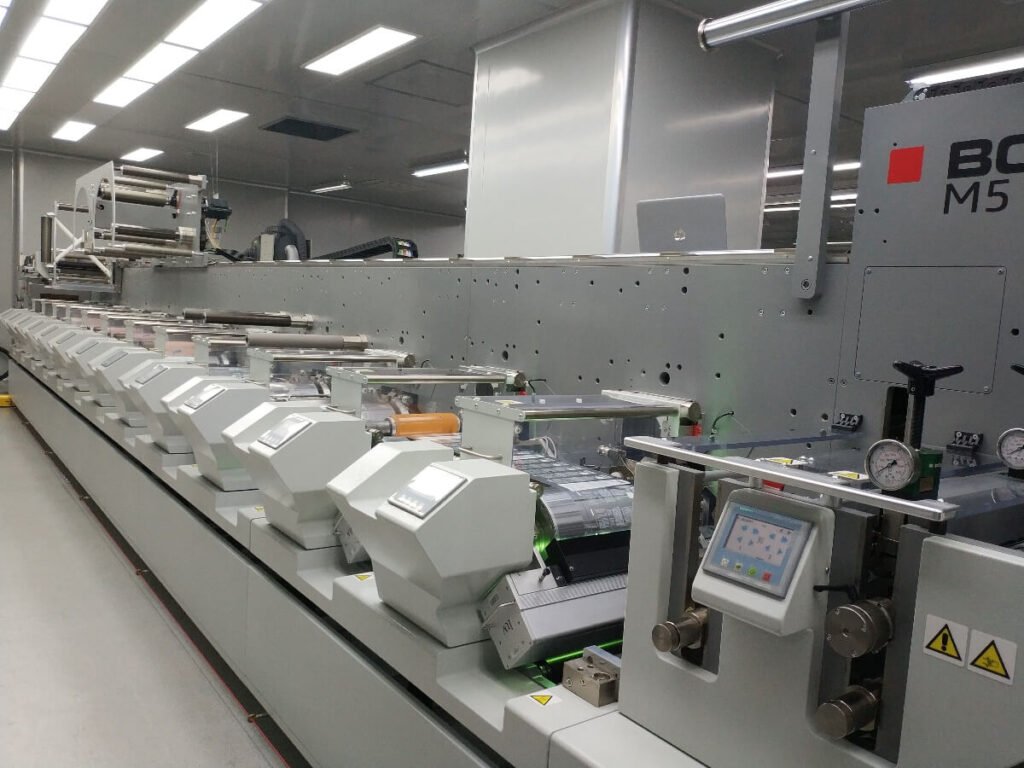Discover the detailed steps of the label printing process, from pre-press to post-press, including key considerations for each stage. Learn about color management and how to ensure high-quality results.
Label printing is a highly specialized process that involves multiple stages, from design to final product.
- Each label printing step requires precise control and attention to detail to ensure the highest quality and consistency.
- This in-depth guide will walk you through the entire label printing process, including pre-press, printing, and post-press, with a focus on key considerations and best practices.

1. Pre-Press Preparation
- Main Tasks: 1, Design and Layout. 2, File Handling and Color Management. 3, Proofing 4, Plate Making (if required).
Key Considerations:
- Design and Layout: Ensure all elements, including text and images, meet the client’s requirements. Check for spelling errors, image resolution, and color mode (CMYK).
- File Format: Provide editable vector graphics or high-resolution bitmap files, typically in PDF format, for cross-platform compatibility.
- Color Calibration: Use professional color management systems to calibrate colors, ensuring screen display matches the printed output. Utilize ICC profiles for accurate color matching.
- Proofing: Provide digital or traditional proofs for client approval before proceeding to full production. Adjust based on feedback until satisfaction is achieved.
- Plate Quality: For technologies like flexography, ensure high-quality materials and experienced technicians are used for plate preparation.
2. Printing Process
- Main Tasks: 1, Selecting the Appropriate Printing Technology. 2, Adjusting Machine Parameters. 3, Controlling Ink Density. 4, Monitoring Registration Accuracy
Key Considerations:
- Printing Technology Selection: Choose the right technology based on order volume, budget, and special effects. For example, use digital printing for small batches and offset or flexographic for large volumes.
- Machine Maintenance: Regularly clean and maintain the printing press. Perform necessary pre-heat and setup procedures before starting.
- Ink Mixing: Follow precise formulas for ink mixing, considering environmental factors like temperature that can affect viscosity.
- Continuous Monitoring: Continuously check the print quality, especially for color consistency and clarity, and address any issues promptly.
3. Post-Press Processing
- Main Tasks: 1, Lamination/Coating. 2 ,Foil Stamping. 3, Die-Cutting. 4, Slitting/Rolling.
Key Considerations:
- Surface Treatment: Ensure even coverage of lamination or coating without bubbles, scratches, or other defects.
- Foil Stamping Precision: Set the correct heat and pressure values to avoid blurry or misaligned foil patterns.
- Die-Cutting Accuracy: Use high-quality dies and regularly check for wear. Be mindful of paper thickness variations that may cause position shifts.
- Slitting/Rolling: For continuous products like roll-fed labels, ensure proper slit width and tension settings to prevent tearing or wrinkling.
Detailed Explanation of the Printing Process
1. Pre-Printing Preparation
Before the actual printing begins, several preparatory steps are necessary:
- Plate Preparation: Prepare the appropriate plates based on the chosen printing technology.
- Ink Mixing: Mix the ink according to the design requirements and material properties, and calibrate the colors using a colorimeter.
- Machine Setup: Adjust the printing machine parameters, such as pressure, speed, and temperature, to ensure optimal performance.
- Substrate Preparation: Choose the right paper or other material as the label substrate and perform any necessary pre-treatment.
2. Printing
Depending on the specific requirements and application, different printing technologies can be used. Here’s a deeper look at some common label printing methods:
For Offset Printing:
- Principle: Offset printing is an indirect method where the image is transferred from the plate to a rubber blanket and then to the substrate.
- Characteristics: Suitable for high-quality, high-volume printing tasks with rich colors and clear details.
- Considerations:
- Ensure good contact between the plate and the rubber blanket.
- Maintain a proper ink-water balance to avoid dirt or blurring.
- Regularly check and replace worn-out rubber blankets.
For Flexographic Printing
- Principle: Flexographic printing uses a relief plate to apply ink directly to the substrate.
- Characteristics: Ideal for various materials, especially self-adhesive labels, offering high productivity and flexibility.
- Considerations:
- Use the appropriate anilox roller to control ink volume.
- Ensure accurate plate installation for precise image placement.
- For multi-color printing, strictly control the registration accuracy between color stations.
For Screen Printing
- Principle: Screen printing uses a stencil (screen) to transfer ink through the open mesh areas onto the substrate.
- Characteristics: Capable of producing thick ink layers, suitable for special effects like fluorescence or metallic finishes.
- Considerations:
- Ensure uniform screen tension to prevent deformation.
- Choose the right squeegee angle and hardness for optimal ink transfer.
- Control the printing pressure to avoid distortion of the pattern.
For Digital Printing
- Principle: Digital printing converts electronic file data into printed images without the need for traditional plates.
- Characteristics: Suitable for short runs, personalized, and variable data printing, offering quick and easy operation.
- Considerations:
- Keep the printheads clean and perform regular maintenance.
- Use compatible ink types to prevent clogging or damage.
- Adjust the fusing temperature according to the substrate type.
3. Online Inspection and Quality Control
To ensure print quality, online inspection systems are often implemented to monitor:
- Color Consistency: Continuously measure sample color values using a colorimeter to ensure batch-to-batch consistency.
- Registration Accuracy: For multi-color printing, ensure each color is accurately positioned.
- Defect Detection: Automatically identify and remove defective products, such as those with stains or broken lines.
- Barcode/QR Code Reading: Verify that barcodes or QR codes are scannable and contain the correct information.
4. Drying and Curing
After printing, depending on the type of ink used, the following drying or curing processes may be required:
- UV Inks: Cured quickly using ultraviolet light, ideal for high-gloss, scratch-resistant, and other special requirements.
- Solvent-Based Inks: Dried naturally by heating to evaporate the solvents.
- Water-Based Inks: Dried through the evaporation of moisture in the air.
5. Troubleshooting and Optimization
Throughout the printing process, various issues may arise, such as color deviations, misregistration, and ink splattering. Technicians must have the experience and expertise to quickly identify and resolve these issues. Additionally, continuous experimentation and improvement can optimize the production process, enhancing overall efficiency and product quality.
Special Focus – Color Management
Importance: Proper color management not only enhances the aesthetic appeal of the product but also reduces waste and saves costs. It is a critical aspect throughout the entire production process, from initial design to final packaging.
Specific Measures:
- Standardized Workflow: Develop a comprehensive and standardized color management workflow covering all aspects from input to output.
- Software and Hardware Integration: Use both software tools and hardware devices such as monitor calibrators and spectrophotometers to support color management.
- Employee Training: Regularly organize training sessions and technical exchanges to enhance the team’s professional skills.
- ISO Certification: Adhere to international standards like ISO 12647 for consistent and predictable print colors, which can further improve the company’s image and service level.
Conclusion
Label printing is a highly specialized field involving numerous complex processes and technical details. Only through rigorous operational management and ongoing technological innovation can we meet the growing market demands and provide high-quality label products. By following this in-depth guide, you can ensure that your label printing process is optimized for success.
For more information on how to optimize your label printing process or to discuss your specific needs, contact our experts today. We provide comprehensive support and solutions to help you achieve the best results in your operations.












